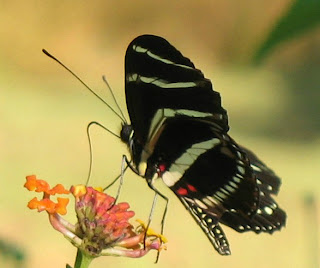I’m not a birder, but I like birds. I like being able to
recognize them. I like being able to support them.
I’m a gardener. In the process of being a gardener, I have
learned more about birds. I’ve learned that what I do in the garden affects not
only what birds come through my garden but also what birds stay in my garden.
The single most important thing I’ve learned is this: birds
eat different things. They don’t all eat seeds, or berries, or sip red-colored
sugar water from glass bottles. Birds can be categorized by what they eat primarily:
- Frugivores eat berries and fleshy fruits. These include cedar waxwings, mockingbirds/catbirds, and tanagers.
- Granivores eat seeds. These include finches, cardinals, sparrows, goldfinches, pigeons, and doves.
- Insectivores eat insects. These include warblers, swallows, wrens, woodpeckers, titmouse, eastern phoebe, bluebird, American robin, brown thrasher, vireos, and the whip-poor-will.
- Nectivores eat nectar. Hummingbirds are the best example.
- Omnivores eat plants and insects both. These include turkeys, crows, and the bluejay.
(There are also birds that eat other birds, dead animals, fish,
and probably other things. Those will not be covered here!)
 |
| Thanks for the seed! |
 |
| Thanks for the caterpillar! |
You’ll need more
insects.
Oh no! Most people don’t want MORE insects. I don’t mean
more mosquitos or more yellow jackets. I mean the insects that eat plants.
Insects that eat plants are mostly caterpillars, and caterpillars are the
larval form of butterflies and moths.
So you need more butterflies and moths. And you need for them to lay eggs ... on your plants. Do you remember hearing about how the monarch butterfly only lays eggs on a certain plant - the milkweed plant? There are many other butterflies (and moths) that have equally specific host plant requirements - their caterpillars only eat certain plants. The Gulf Fritillary and the Zebra longwing butterflies lay eggs on passionflower (Passiflora). Some butterflies have several host plants - the eastern tiger swallowtail butterfly lays eggs on several
different host plants – tuliptree (Liriodendron tulipifera), black cherry (Prunus serotina), spicebush (Lindera benzoin), and sassafras (Sassafras albidum). Every butterfly and moth has one or several host plants - and they are native plants.
 |
| Zebra longwing on nectar plant |
That's right - native insects prefer to munch on native plants. And since most of our insects are native insects ... you'll have much more food for the birds when you use native plants.
If you'd like to learn more about what plants you can incorporate to increase the biodiversity of insects (and birds) in your yard, have a look at this "top twenty" chart with data from Doug Tallamy. It provides the top twenty woody and the top twenty herbaceous plants (by genus) in the mid-Atlantic region. That works pretty well for those of us in Georgia too.
If you'd like to learn more about what plants you can incorporate to increase the biodiversity of insects (and birds) in your yard, have a look at this "top twenty" chart with data from Doug Tallamy. It provides the top twenty woody and the top twenty herbaceous plants (by genus) in the mid-Atlantic region. That works pretty well for those of us in Georgia too.

Nice post! I think birds provide a lot of energy and movement in the garden. I like to attract all variety of birds. We even have some buzzards that like to sit on top of our house. Yesterday a red tailed hawk perched itself right on the hook of one of the bird feeders! I am very much looking forward to hearing Doug Tallamy speak. Looks like he is doing a circuit in Georgia next month.
ReplyDeleteThis post is just what I was looking for! I'm planning to start a garden next growing season in central New York, and I've been hoping to attract birds besides the crows and blue jays that I see all the time. Now I have a great starting point...thank you!
ReplyDeleteEllen, I love this post. A fresh look at the native plant-bird connection. I've been on the Tallamy bandwagon for years now, and occasionally I struggle with the repetitiveness of sending out the same message. Kudos definitely in order for this one! If you get the chance to see the new film "Flight of the Butterflies," don't miss it.
ReplyDeleteGreat post Ellen. I like to watch the different behaviors of birds in my yard, the sparrows that jump-scratch the leaf litter for insects, the waxwings seeking out Red Cedar berries and the migratory warblers looking for caterpillars on my native shrubs. I learn so much every year from the birds just by watching what they do and eat.
ReplyDeleteI enjoyed your post. I got interested in native plants because of my interest in birds.
ReplyDeleteJust a couple of friendly noteds...The bird on the beautyberry is a Mockingbird and not a Catbird. Also you mentioned red sugar water for hummers... and I thought I'd throw out there that many people feel that you should not use red food dye. Here's a link http://wildbirdsunlimited.typepad.com/the_zen_birdfeeder/2010/07/top-5-reasons-to-not-use-red-hummingbird-nectar.html
Would you give me permission to use your mockingbird/American beautyberry photo in the new edition of my book Gardening with Native Plants of the South?
ReplyDeleteGreat post on the benefits of native plants. If you really want to see the incredible diversity of life that native plants support, focus on the moths. Look for a local group to host a “moth lighting”, where they hang up sheets and focus bright lights on them at night. You’ll be amazed at the diversity of moths and other insects that appear. And Peterson Guides just put out a Field Guides to Moths of Southeastern Noth America. Definitely check it out if you’re interested.
ReplyDelete